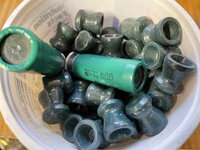- Messages
- 2,755
- Reactions
- 3,490
I piled all my gear together and scrap lead getting ready to plug her in for the first time to cast some slugs and buckshot etc. I have Brownells Marvelux flux but read in a review or two (doubtful credibility W/lots of positive reviews) that it rusted their melter.
I figured I still have quite a few other small projects to wrap up before I actually get around to it. So figured I'd ask:
Any tips for keeping the pot clean and rust free? Ditch the fancy flux and just use good ol' beeswax? Am I fine and making a big deal out if nothing?
TIA!
I figured I still have quite a few other small projects to wrap up before I actually get around to it. So figured I'd ask:
Any tips for keeping the pot clean and rust free? Ditch the fancy flux and just use good ol' beeswax? Am I fine and making a big deal out if nothing?
TIA!












